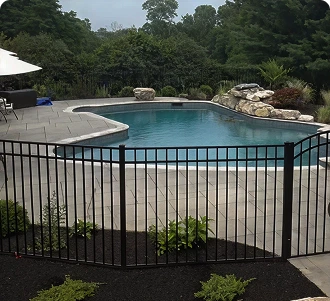Steel or Aluminium? How to Pick the Right Fencing Material by Job Type
This guide breaks down which fencing material to use for common Melbourne trade installs, from boundary runs to screens and gates.
1. Boundary Fences for Side & Rear Lots - Steel
For long boundary runs between properties, steel is the standard. Most Melbourne builders, developers and fencing installers use Colorbond-style systems.
Why it works:
- Strong and secure
- Low maintenance
- Offers privacy and wind protection
- Quick to install over large runs
- Matches common developer guidelines
What to use:
- Metline castellated steel sheets (Colorbond-compatible)
- Posts, rails, capping, screws — all in matching colours
- Heights: typically 1.8m, with custom options available
- Colours: Woodland Grey, Monument, Basalt, Surfmist, and more
When aluminium doesn’t suit:
- Aluminium slats don’t provide full privacy
- Not cost-effective for long boundary runs
- Less robust in high-wind or high-impact areas
Tip: Steel is often the developer default in new estates — confirm spec before quoting.
2. Front Fences and Street-Facing Areas - Aluminium
When the job is about appearance and presentation, aluminium is the go-to. Slat fencing offers a modern look with flexibility in spacing, orientation, and design. Throughout Melbourne, aluminium slats are often popular for front fences under 1.5m where councils restrict solid walls.
Why it works:
- Sleek, architectural appearance
- Easily customisable
- Horizontal or vertical slats
- Powder-coated in a range of colours
- Lightweight, corrosion-resistant
- Can be used for fences, screens and matching gates
What to use:
- Aluminium slat systems (65mm and 90mm profiles)
- End frames, slats, caps, fixings, and gate kits
- Common colours: Monument, Woodland Grey, Black, Surfmist
- Adjustable spacing for semi-privacy or full cover
When steel doesn’t suit:
- Steel fence sheets can look too industrial
- Less flexibility in style or spacing
- Overkill for decorative or non-boundary locations
3. Side Gates, Pedestrian Gates, Entry Features - Aluminium or Steel (Job Dependent)
For gates and entry points, the right material depends on matching the fence system and managing weight vs durability. Always match the gate system to the fence, so that you are not mixing slats with sheets unless the fence is clearly designed that way.
When to use aluminium:
- Lightweight, easier to hinge
- Matches slat systems
- Easier to automate or swing
- Doesn’t rust near moisture-prone zones
When to use steel:
- Matches Colorbond steel fencing
- Heavier, more secure for side entries
- Better where privacy is critical
What to consider:
- Frame strength
- Hardware: hinges, latches, locks
- Ground conditions for posts
- Gate width and swing direction
4. Pool Fencing and Garden Dividers - Aluminium Tubular
Steel isn’t used for pool fencing. It’s too heavy, rust-prone, and not compliant with pool safety codes. Tubular aluminium is standard for pools and child-safe zones. Pool fencing must meet strict specs, so always check with your certifier or local council before ordering.
Why it works:
- Compliant with Australian pool regulations
- Lightweight and easy to install
- Powder-coated and rust-resistant
- Available in pre-fab panels and gates
- Can be stepped or raked for sloping sites
What to use:
- Pre-made aluminium pool fence panels
- Matching gate kits, posts, caps, latches
- Check local pool code height and spacing requirements
5. Commercial and Utility Areas - Steel
When security is the priority such as in warehouses, service yards, or back-of-house fencing, then steel is more suitable.
Why it works:
- Stronger against impact or tampering
- Suitable for high-traffic and vehicle-access areas
- Can be combined with gates, bollards or security screens
Optional upgrades:
- Add steel lattice for height without full block-out
- Use reinforced posts or concrete-in rails
- Install signage or service access gates into panels
Quote clearly on commercial jobs as many clients assume all steel is Colorbond, but industrial settings may need heavier posts or anti-climb designs.
Comparison Table: Steel vs Aluminium Fencing at a Glance
Job Type | Material | Why It's Best |
Side/rear boundary fences | Steel | Privacy, strength, fast to install |
Front decorative fences | Aluminium | Modern look, flexible spacing |
Pedestrian side gates | Both | Depends on fence system and weight |
Pool areas and garden dividers | Aluminium tubular | Compliant, corrosion-resistant |
Commercial/security areas | Steel | High strength, secure, suits industrial installs |

Summary: Match the Material to the Job
Steel and aluminium both have their place in trade installs. The key is to match the right product to the job, not just quote what you used last time.
- Use steel for boundary fences, back lots, and commercial jobs.
- Use aluminium for front fences, screens, gates, and anywhere design matters.